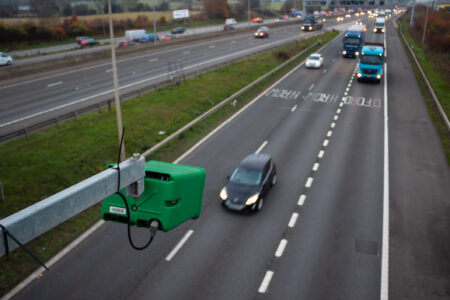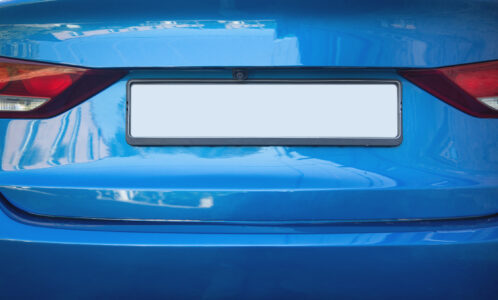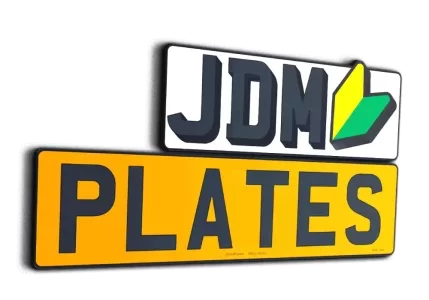What Are Ghost Number Plates? Everything You Need to Know
You’ve probably come across the term “ghost plates” over the past few months, whether in the news, forums or from fellow car enthusiasts. But what are ghost number plates? And why are they making headlines in the UK?
From questions about legality to concerns over privacy and ANPR evasion, it’s time to clear up the myths and present the facts. ANPR systems require clean and unobstructed number plates to function accurately, and any modifications, dirt, or obstructions can lead to potential evasion of law enforcement. Whether you’re a performance car owner, a plate customisation enthusiast, or simply curious, this guide covers everything you need to know.
What Is a Ghost Number Plate?
Ghost number plates, also known as “stealth” or “invisible” plates, are often believed to be designed to evade Automatic Number Plate Recognition (ANPR) cameras. In reality, the term is heavily misused.
Many people think a ghost plate becomes unreadable under certain lighting conditions or when viewed from specific angles. Often, these are highly stylised plates that incorporate 3D, 4D, or tinted acrylics. While these might look unique or “ghost-like,” they are not necessarily illegal.

Why the Confusion Around Ghost Plates?
The confusion largely stems from misleading journalism and viral social media posts. Some custom number plate sellers label their products as “ghost plates” for marketing, while media outlets suggest they are tools for criminals.
However, most ghost-style plates sold in the UK conform to the required British Standard BS AU 145e and are perfectly legal as long as they meet reflectivity, size, font, and spacing rules. At JDM Plates, we are committed to providing accurate and responsible information to clear up any misconceptions about ghost plates.
How Do Ghost Plates Work?
Illegal ghost plates are designed to evade detection by Automatic Number Plate Recognition (ANPR) cameras, which rely on infrared light to read number plates. These plates are modified using reflective materials or coatings that disrupt the camera’s ability to reflect light and accurately capture the plate’s characters. These modifications can include sprays, films, or physical plate surface alterations.
When an ANPR camera attempts to read a ghost plate, the reflective materials or coatings obscure the plate’s details, making it difficult or impossible for the camera to detect the vehicle’s identity. This evasion technique can avoid detection by speed cameras, bus lane cameras, and other types of ANPR cameras, allowing motorists to evade fines and penalties.
The use of illegal ghost plates raises significant concerns for road safety, as it enables criminals to conceal their vehicle’s identity and avoid detection by law enforcement. The UK government and police forces are actively working to tackle this issue, proposing to increase penalties for motorists caught using ghost plates.
The DVLA is also addressing the issue by improving the security and integrity of number plate registration and detection. Motorists who use ghost plates can face severe consequences, including fines, penalty points on their driving license, and potential criminal charges.
Are Ghost Plates Illegal in the UK?
This is the million-pound question: are ghost plates illegal?
The short answer? It depends. If a number plate is designed to obstruct ANPR cameras or is not readable to the human eye, it’s considered non-compliant. It is, therefore, illegal under UK law, putting drivers at risk of fines and penalties. According to GBNews, Labour want to implement the penalty of £1000 in fines and up to 6 points if ever caught using illegal ghost plates.
Legal vs. Illegal Ghost Plates – Illegal Number Plates
Here’s how you can differentiate:
- Legal Ghost Plates: These conform to BS AU 145e, use legal fonts and spacing, and are fully reflective. They might use 2 layers of 4D characters but remain camera-readable.
- Illegal Ghost Plates: These use mirrored finishes, reflective blockers, allow infrared through, or excessive tinting, making them hard or impossible for ANPR systems to scan.
If your plate can’t be read by the police or ANPR systems, you risk fines, MOT failures, penalty points, or even having your car seized. Suppliers must ensure they only supply number plates that comply with British Standards to avoid legal repercussions.

How Do Ghost Plates Affect ANPR Systems?
ANPR (Automatic Number Plate Recognition) systems rely on cameras and infrared cameras to read number plates for tolls, law enforcement, and congestion charges. Ghost plates that are non-reflective or use tampering materials interfere with these systems.
Consequences of ANPR Evasion & Ghost Plate Speed Cameras
Attempting to evade ANPR systems using illegal number plates & illegal plate modifications are a serious offence that can facilitate various crimes. Here’s what could happen:
- Up to £1,000 fine
- Vehicle seizure or impoundment
- MOT failure
- Points on your driving license
The connection between Ghost Plate Speed Cameras is one of the main reasons authorities are cracking down. Because number plate recognition cameras rely on ANPR technology to identify vehicles breaking the law, drivers using ghost plates may believe they can avoid fines or points. In reality, police treat the use of ghost plates to evade speed cameras as a serious offence, with penalties similar to or even harsher than those for speeding itself.
Remember, while “ghost plate” sounds cool, the consequences aren’t
Prevention and Detection of Ghost Plates
To prevent ghost plates, number plate manufacturers must ensure their products comply with the British Standard (BS AU 145e) and are fully compliant with ANPR camera technology. Using stealth plates, designed to evade detection, is illegal and can result in severe penalties for both motorists and suppliers.
Police forces and other authorities are employing various methods to detect and prevent the use of ghost plates, including specialised cameras and detection equipment. ANPR cameras are being upgraded to enhance their ability to detect and read number plates, even those with reflective materials or coatings.
The public can also play a crucial role in preventing the use of ghost plates by reporting any suspicious activity or vehicles with modified number plates to the authorities. The UK government is considering introducing harsher penalties for motorists caught using ghost plates, including fines of up to £1,000 and six penalty points on their driving license.
The issue of ghost plates is a significant concern for road safety, and public awareness is vital in tackling it. Number plate suppliers must ensure they are providing fully compliant number plates that meet the British Standard and are readable by ANPR cameras. The use of ghost plates can have serious consequences, including enabling criminals to conceal their vehicle’s identity and avoid detection by law enforcement.
By working together, the government, police forces, and the public can help prevent the use of ghost plates and improve road safety in the UK.

Are Ghost Number Plates Just a Myth?
The term “ghost plate” is largely misunderstood. Many plates labelled as ghosts are simply stylised number plates that are fully legal and camera-friendly which consist of a base 4D character and an outer, 2nd 4D layer, outer perimeter.
In fact, some high-quality 4D plates sold by reputable retailers like JDM Plates are compliant with all DVLA regulations.
If you’re unsure whether your plate meets the standard, use our Number Plate Generator to explore legal custom options.
It is crucial to protect the integrity of information and ensure that the public is not misled by myths and misconceptions about ghost plates.
Which Plate Styles Are Mistaken for Illegal Ghost Plates?
Here are some styles that often get confused with illegal ghost plates:
- 4D Gel Plates
- Toned Acrylic Plates
- Black Backed Plates for Show Use
- Imported Vehicle Plates with Size Adjustments
You can still get a bold, standout look while staying legal. Just ensure the plate remains visible under all lighting conditions and meets the character height, spacing, and reflectivity standards.
Ensuring that your number plates comply with all legal standards is essential to avoid penalties and ensure road safety.
How to Check If Your Plate Is Road Legal
Here’s a quick checklist:
- Is the plate made to BS AU 145e standard?
- Is the text in the correct Charles Wright font?
- Does it have the right spacing and margins?
- Is it reflective?
- Is the supplier registered and listed with the DVLA?
If your answer is “yes” to all the above, you’re in the clear!
The scale of compliance with these standards is crucial for maintaining road safety and ensuring that all vehicles are easily identifiable.
Can You Get Custom Plates That Look Like Ghost Plates But Are Legal?
Yes. Many plate designers now offer sleek, compliant designs that give off a “ghost-like” vibe without breaking the law. These include:
- Double layered 4D digits with the top layer showing just the perimeter.
- 3D/4D letters.
- Custom sizes for imported cars with DVLA approval
If you own a JDM import, you can create a smaller-sized legal plate using our plate generator tool to maintain your aesthetic while remaining compliant.
Custom plates for private hire vehicles must also comply with all legal standards to ensure they are road-legal and easily identifiable by ANPR systems.
Should You Use Ghost Number Plates or Avoid Them?
If you’re in the market for unique plates, there’s nothing wrong with styling your ride. Just ensure you understand the difference between style and stealth.
Ghost plates, if designed to hinder enforcement tech are not only illegal but also dangerous. But the good news is, you can still turn heads and keep your registration 100% legal.
The penalties for using ghost plates can be as severe as those for speeding, including hefty fines and points on your driving license.
Ready to Create Your Own Legal Custom Plate?
Explore legal custom plate options using our Number Plate Generator or shop the full range at our store.
If you’re unsure about what’s road legal and require further information, contact the team at JDM Plates; we’ll guide you through it without the jargon.

